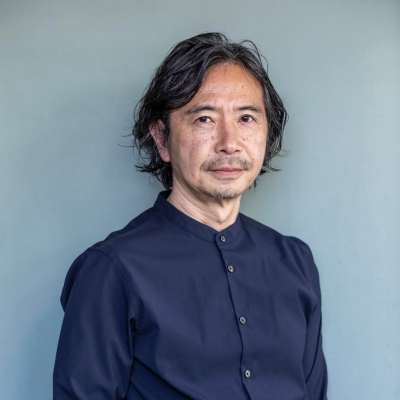NEW Article
-

9 Education & Geo-gastronomy
“Let’s think about ways to minimize food mileage,” “If we can reduce meat consumption by promoting vegan foods, we can cut CO2 emissions,” and “I wonder if there are any local foods that have gone unnoticed…”—These are some of the remarks from a class of sixth grade students at the Keio Yochisha Elementary School. The classroom discussion among these sixth grade students is gaining momentum as they seek to widely communicate their ideas to society. In November 2021, one class from the sixth grade at Keio Yochisha Elementary School participated in the Islander Summit Ishigaki, giving an online presentation on the theme “Food of the Future.” For me, developing ambitions and ideas to transform society for the better is an important part of education. As such, using my position as a teacher, I have sought to shine a light on the relationship between the environment and food—something which children will be familiar with—and set up the following activities on the “Food of the Future” theme. October – A lesson from Kenichi Watanabe, representative at Geo Gastronomy, introducing a whole range of food-related issues and advanced case studies. – An online lecture and interaction with Tomoko Kitamura Nielsen, environmental director on the Danish island Lolland, talking about food-related environmental awareness in Denmark and advanced case studies. – An online lecture and interaction with Hitoshi Sugiura, winner of the gold prize at the World Vegan Cooking Contest, about the environmental impact of food and vegan cuisine. – Use of official World Food Forum videos as teaching materials to further understanding of the diversity, cyclicity, and sustainability of food. November – Presentation at the Islander Summit and comments from experts. – Online lecture and interaction with Prof. Seiko Shirasaka from the Graduate School of System Design and Management at Keio University about advanced space utilization and environmental issues from a space perspective. Something that every child around the world does every day is sit down for a meal. Helping children understand the relationship between food and the environment can help them realize the close link between themselves and society’s problems. In the lesson from Kenichi Watanabe, children were surprised to learn about the katemono (edible wild plants) recipes that were made to overcome hunger in the Yonezawa domain during the Edo period. Some children suggested that if we had a modern-day version of these katemono recipes, we might be able to help countries […]
Read more -

10 The Course of Action for Plant-based Gastronomy—Our World in 2050
The outbreak of the COVID-19 pandemic in 2020 has led to drastic changes in today’s lifestyles and habits, and there is a sense throughout society that we have entered a new phase. At the same time, we are also beginning to feel the impacts of worldwide social issues such as global warming in our daily lives. For example, in addition to torrential downpours becoming the norm in recent years, every year we are seeing typhoons of record-breaking scale. We are also experiencing major changes elsewhere, with declining fish catches, seasonal changes, and poor harvests of previously stable vegetables and other crops. As civilization has advanced and the quality of our lifestyles has improved, unknowingly, we have also been causing huge damage to the global environment. Further, with a global population explosion on the horizon, some say that we will require two earths if we are to continue with our current way of life. Against this backdrop, countries across the world are coming up with diverse ideas to tackle these environmental issues, engaging in various initiatives to rebuild the planet. In gastronomy, eating is the common denominator among people worldwide that is essential to sustaining life. I believe that food can provide one solution to these environmental issues, and have realized the importance of promoting and developing environmentally friendly lifestyles through food. A plant-based diet is one solution that can have an effective outcome for the global environment. This plant-based diet has been closely related to the Japanese diet since ancient times. One example is shojin ryori, a vegetable-based Buddhist cuisine, which is a key part of Japanese food culture. Shojin ryori was first introduced to Japan in the 13th century. A lack of logistics at the time meant that individuals would source local, seasonal ingredients themselves, only taking the necessary amount to ensure harmony with nature and show their appreciation for nature’s blessings. This was a self-sufficient, sustainable way of life. This ancient approach can help us rethink the gluttony in modern society. My hope is to promote lifestyles that can have a positive effect on both health and the environment. With the knowledge that I can help people improve the environment in a stress-free manner through dining, whether at home or restaurants, I have therefore taken action. One initiative that I have developed for society is the 1,000 Vegan Project, through which we aimed to switch from regular meals […]
Read more -

11 The Direction of Japan as a Tourism Hotspot—Terroir and SBNR through VISON
The French word terroir, frequently used in the wine industry, comes from another French word, terre, meaning “land.” Terroir refers to a combination of natural factors that give products their unique, locally rooted characteristics, including geography, terrain, and climate. At BuzzFeed, which is one of the largest digital media outlets in the US and Japan, we feature various articles from a diverse range of fields. During the pandemic, however, when there were restrictions on returning home and other forms of travel, there was a particular rise in interest in news about locally rooted food. In FY2021, we released 34 articles tagged #deliciouslocalfood, which were shared more than 25,000 times on social media, accumulating more than 1.25 million views. In this article, I would like to consider how to apply current reader interest to post-COVID-19 tourism. VISON, one of Japan’s largest commercial resorts, opened in July 2021 in Mie Prefecture based on the concept “Alongside Our Region.” Mainly through markets offering fresh fish from the nearby Kumano-nada sea and fresh local vegetables, as well as restaurants and hotels, VISON aims to provide experiences based on “healing, food, and knowledge,” combining tradition and innovation to revitalize and create new regional economies. At the same time, VISON also plays a key role in solving regional issues that are common throughout rural areas in Japan, including population decline, ageing communities, and worker shortages in agriculture and forestry. The core concept of this resort is terroir, or in other words, local production for local consumption. By providing this terroir and attracting people from outside the region—who typically spend more than local customers—, the region can acquire foreign currency. In turn, this can help maintain high wages and ensure high-quality local employment. Using cuisine to communicate the appeals of the region’s ingredients, culture and worldviews to visitors from outside the region can ultimately help to solve the issues that the region faces. To solve local issues through the new employment of 1,000 people, VISON is aiming to attract around eight million visitors a year, which is around the same number as one of Mie’s most popular tourist destination, Ise Jingu Shrine. Meanwhile, interest in “spiritual but not religious (SBNR)” activities, such as mindfulness, meditation, and yoga, is growing on a global scale. According to the Pew Research Center in the US, approximately a quarter (27%) of American adults consider themselves to be SBNR. The prolonged pandemic […]
Read more -

13 Pointers for Circular Economies from Satoyama Culture
More than ten years have passed since COP10 was held in Nagoya and the world was introduced to the concept of satoyama—a unique environment where people and nature coexist in harmony— and the concept seems to be gradually taking root. Elsewhere, the impacts of climate change are becoming more apparent worldwide, and the COVID-19 pandemic has demonstrated the need for society to take a new direction. While the definition of circular economy seems to vary to region, the main concept is that—in contrast to a linear economy (use and dispose) and even reuse—a system where used products and materials disposed in the production process are reproduced into new products, given new value, and then sold again. In many rural regions of Japan, where the satoyama wisdom has been passed down from generations to generations, this circular approach is a core of people’s lives and continues to this day. With rice, for example, the ingredient in Japanese sake and sushi, both of which are becoming increasing popular worldwide, an incredibly efficient cycle has been in place for generations. It is a well-known fact that sake lees, a byproduct of sake brewing, are used to make amazake (a sweet, non-alcoholic sake) and a wide range of pickles including Narazuke. Meanwhile, in the production of daiginjo and other types of sake with high rice polishing ratio, a large amount of rice flour is generated as a byproduct. This rice flour is reused in rice crackers and dumplings. Rice bran is another byproduct of the production process, and in the Hida area of Japan where I live, this has been reused as a kind of wax for polishing the floors and pillars of wooden houses for many years. Further, after the rice bran has been used to care for the home, it is then scattered onto nearby fields, returned to the soil, and reused as fertilizer for new crops. Examples such as these are too numerous to see throughout satoyama areas. Another example can be seen in the use of the kaya grasses used to make thatched roofs, such as those in the UNESCO World Heritage site of Shirakawa-go. Harvested grass is used as snow shelters in the drying process, and then used for thatched roofs after drying. Later, part of the roof that have been damaged by wind and rain is removed and reused as livestock feed. This is then digested by the […]
Read more -

14 Food and Food Culture are Key to Environmental Solutions
Today we face various global issues, such as global warming due to human activities, loss of biodiversity, nitrogen pollution, and COVID-19. From Japan, it might seem like some of these are irrelevant matters in a faraway world. However, with products and information travel all across the globe in the blink of an eye, the world has gotten smaller. Things that have been pushed off as a hassle sometimes come back full circle. Japan procures food, animal feed, raw materials, and fuel from various countries worldwide, and bears a great deal of responsibility for future possibilities. That is, if Japan gets serious about solving these global issues, it can make the world better connected through trade. This is perhaps the very purpose of Cool Japan. Moving on, some of you may be unfamiliar with nitrogen pollution. Nitrogen is an essential element for proteins, nucleic acids, and other biomolecules. Humans absorb nitrogen from food proteins. Nitrogen (N2) is ubiquitous, and accounts for around 80% of the Earth’s atmosphere. However, N2 is incredibly stable and cannot do much by itself. Only when it is transformed into a reactive compound such as ammonia can it be used as a fertilizer for crop production, a raw material for industrial production, and a fuel for energy production. Technology for the artificial synthesis of ammonia was put to practical use in the early 20th century, and since then nitrogen has brought great benefits to us as a fertilizer for mass food production. That said, much of the nitrogen we use is released into the atmosphere in a reactive state. This in turn leads to a wide range of environmental problems such as global warming, stratospheric ozone depletion, air pollution, water pollution, eutrophication, and acidification. These combined environmental impacts are known as nitrogen pollution. Our world is huge but finite. Including ourselves, there are many different living things in the world, and we all influence and impact each other. Human activities have become so large that they have drastically changed the material cycle and in turn caused various environmental problems. In doing so, we have made the world more difficult for other organisms to survive. There are many things we can do to ensure that future generations can live in happiness, and to ensure that the world’s living things can remain as they are. Food is one element of our daily lives that is closely linked to global […]
Read more -

15 A “Delicious” Economy to Change the Future of Society—Living in a Country with the Best Food in the World
Japan can perhaps be called the country with the best food in the world. In a global survey asking which countries people most want to visit after the pandemic, Japan was number one among people living in Asia and number two among those in Europe and the US. In both cases, Japan was at the top end of the list. Moreover, the number one reason people wish to visit Japan is said to be for its food. As this suggests, while many foreign visitors to Japan come in search of delicious food, Japan in fact has the highest number of Michelin-starred restaurants in the world. The total number of stars and three-star restaurants in Tokyo far exceeds that of Paris, which can be called the home of Michelin star framework. A characteristic of the restaurant industry in Japan is that many Japanese chefs have honed their skills not only in Japanese cuisine, but also in French, Italian, and other foreign cuisines, and have earned Michelin stars. Further, outside of Michelin stars, there are countless numbers of Japanese chefs who have won first place in international cooking competitions such as the Pasta World Championships and the World Pizza Championships. We can therefore say that Japan is the country that evolves tastes of other countries in more delicious way. Elsewhere, Japan has an abundance of delicious, seasonal foods from both the sea and the mountains. Thanks to an excellent supply chain, customers can consume these ingredients while they are still fresh. Meanwhile, advanced fermentation techniques developed in the preserved food culture have broadened the range of umami flavors. There are many positive aspects of Japanese food, such as the diversity of food culture, which varies from region to region, including traditional and local cuisine, and the high level of “seasoning technology” in factories producing seasonings and processed foods. Alongside its “deliciousness” technology, Japanese food is also highly regarded worldwide for its health benefits and for its lower environmental impact compared to Western food. In 2005, the number of Japanese restaurants overseas stood at approximately 25,000. In 2010 this number doubled to 50,000, and expanded to 150,000 in 2020. With such wonderful characteristics, it is essential that we seriously address how to maintain and develop our globally respected food culture. Doing so can help Japanese food culture maintain its dominance over the centuries. In a future of exploding world population, food will become […]
Read more -

17 A Rapidly Growing Green Shift in the Food Industry in the Global—Volume 1: Introduction
Based on the motto “Clues and Markets Can Be Found Overseas,” my activities are centered on Lifestyle Researcher, a global network of more than 600 Japanese women who have lived long-term in 100 cities in 70 countries worldwide, and work locally in various fields such as journalism and research. I hope to have an opportunity to tell you later why we focus on Japanese and why we specialize in women. I have been working in overseas businesses for nearly 20 years using this unique framework, and my utmost priorities have been the local consumer perspective and local living environment and conditions. Based on the title “A Green Shift in the Food Industry,” in this first article I will introduce several trends I have discovered in overseas countries by hearing from local people, feeling local signs and trends, and sensing changes in society and values. I would also like to examine my hypothesis on how this global green shift in the food industry can be a major driving force for Japanese washoku culture, gastronomy, and overseas strategies to attract inbound tourism. To help me with my work, I enlisted the help of Lifestyle Researchers from seven different countries: the UK, France, Denmark, the US, Mexico, South Africa, and Singapore. Here I will outline what sort of unique guidelines and visions that governments and public organizations in each country have for promoting this green shift. One major movement is the Green Industrial Revolution announced by the UK government in autumn of 2021. The Industrial Revolution began in the UK in the 19th century and sought to create the convenient and efficient society we live in today. The idea behind the Green Industrial Revolution is to reset the current carbon-based society and achieve a green shift to a zero-carbon society. In line with the above announcement of the Green Industrial Revolution, the UK Department for Environment, Food & Rural Affairs examined a set of guidelines to promote zero carbonization while maintaining food security. As a result, the department launched the Farming Innovation Programme to introduce technologies to promote low-carbon agriculture. At COP26 in Scotland in 2021, the UK Food and Drink Federation —made up of more than 1,000 food-related companies—announced a statement to make the domestic food industry a zero-carbon society. The food served at COP26 was made with local ingredients and beverages were provided in recyclable cups. In these and other ways, […]
Read more -

19 Understanding Value Shifts in the New Generation Through Social Listening
Today, more than 90% of the world’s populated areas are always connected to the internet. People interact digitally through social media and other online means, and capitalized on their reputations through shares, likes, and comments. This reputation permeates society as capital, and can be called evaluation capitalism . Until now, people have engaged in economic, lifestyle, cultural, and social activities using monetary capital, labor capital, social capital, industrial capital, and other capital as yardsticks. In today’s society, however, visualizing and analyzing this so-called evaluation capitalism, for example, what people around the world value, what they are interested in, and how their values have changed, is effective for recognizing the current state of society and predicting the future. The COVID-19 pandemic in particular has drastically shifted in people’s values and driven the creation of new frameworks for social systems, economic conditions, and national policies. Moving forward, my aim is to strengthen the three scientific viewpoints and use them to create a framework for the next generation of Cool Japan strategies. In Japanese, these three viewpoints are known as tori no me (bird’s-eye view: overarching analysis of the ecosystem), mushi no me (insect’s-eye view: observational analysis of mechanisms), and sakana no me (fish’s-eye view: comparative analysis of flows and trends). The Intellectual Property Strategy Headquarters at the Cabinet Office and the Cool Japan Public-Private Partnership Platform (CJPF) have released an infographic summarizing the key findings of their joint global social listening survey. While analysis of the results yielded a variety of findings, simply put, the survey indicated that the SC era is progressing, for example, sustainability, social, circular economy, and community. As the major shift in values which can be called the first year of green Cool Japan activities is needed, CJPF is reviewing its whole strategy with food and food culture as a starting point. Specifically, we have outlined three steps: discovery, empathy, and co-creation. Using both tangible and intangible resources of Cool Japan, we hope to create a companionate framework in which people from around the world and in Japan can transcend barriers and work together to create the next generation. We believe that reorganizing Japan’s cultural value from a global perspective and a future-oriented approach, and upcycling society and the economy on a regional scale are the new Cool Japan strategy of the future. As the first step, we have launched our on-demand media platform cjpf.jp to analyze so-called […]
Read more -

Kita-Kanto
7 Become a Kurabito. Enhancing the Value of Japanese Sake through a New Form of Sake Brewery Tourism
KURABITO STAY and Kitsukura Shuzo have teamed up to offer a completely new sake tourism program within the grounds of a 330-year-old sake brewery. This new program enables visitors to stay at a renovated, century-old lodging that was used by former kurabito, or sake brewers, at the Kitsukura Shuzo sake brewery in Saku, Nagano Prefecture. In addition to enjoying locally produced sake and delicious local dishes during their stay, guests can take part in the sake brewing process. It is an activity that fans of Japanese sake will want to experience at least once. Held on weekends only, since its launch in March 2020, the special program has been so popular among guests that some have even come back for more. KURABITO STAY, Inc. is the company responsible for developing and running the program. President Marika Tazawa’s aim is to boost sake-related tourism, engage in new branding activities for sake breweries, and promote tourism that brings joy to everyone involved.
Read more -

1 The Future of the UNWTO’s Gastronomy Tourism Initiatives
According to a survey by the World Tourism Organization (UNWTO), in recent years, the number of tourists who prioritize experiencing the regional lifestyles and cultures of their destination by enjoying the local cuisine is increasing at around the same rate as those who visit tourist hotspots. These tourists have a strong desire for authenticity and tend to consume more than the average tourists. Gastronomy tourism is defined as “A form of tourism that aims to experience the local culinary culture and to enjoy food nurtured by the ingredients, culture, customs, traditions and history created by the local climate.” In today’s post-COVID-19 society, overtourism and other tourism issues prior to the pandemic have made initiatives for the SDGs more important, while awareness of the importance of sustainable tourism—in terms of the economy, society, culture and environment—is gradually increasing. Gastronomy tourism is closely linked to the local natural environment, agriculture and culture. Further, gastronomy tourism, which anyone can participate and which contribute to participants’ health and happiness, can be considered an effective way for achieving sustainable tourism. Moreover, the origins of many types of cuisine can be found in the local history and culture. Food is therefore an ideal contents to highlight a region’s characteristics, and can be one of the great pleasures of travel. In a survey conducted by the Japan Tourism Agency, the primary attraction for foreign tourists visiting Japan was “eating Japanese food”, while in sixth place was “drinking Japanese sake”. As a result of the above, local governments around Japan are proactively engaging in gastronomy tourism initiatives to achieve regionaldevelopment. The UNWTO lists the following five reasons for the focus on gastronomy tourism: (1) It is an effective way for regions to differentiate themselves; (2) it can provide visitors new values and experiences; (3) it can be initiated even in regions with few tourism resources; (4) it is conducive to tell regional stories; and (5) it promotes tourists to revisit. Below are three initiatives led by the UNWTO for gastronomy tourism. The first is a report that the UNWTO published in 2019 called Gastronomy Tourism – The Case of Japan. This report features 18 excellent examples of gastronomy tourism activities in Japan. The report follows a survey of Japan’s 1,741 municipalities, of which 584 responded. It shows that gastronomy tourism activities in Japan are more comprehensively focused on sustainable regional development and collaboration with agriculture than tourism promotion […]
Read more
記事検索
キーワードから探す
- すべて
- Ryotei & Restaurants
- Lodging/Hotels
- Producers
- Technology
- DX (Digital) & SNS
- City Planning
- Utilization
- Gastronomy and Culinary
- Japanese Nature
- Japanese history and traditional culture
- Japanese Food Culture
- Agriculture
- Fisheries
- SDGs
- Local production for local consumption
- Foreigner Activation
- Experience
- Overseas Expansion
- Fermentation
- Public-private partnerships and collaborations
- Sake
- Community Revitalization
- Spirituality
- Japan of the Sea
- Mountain Japan

